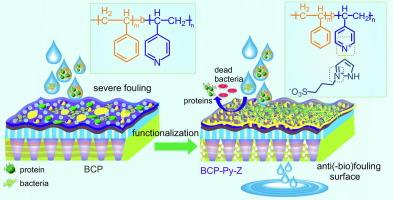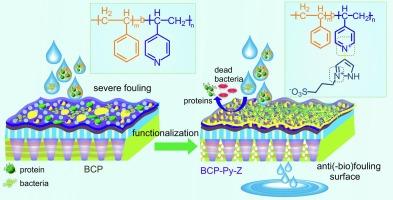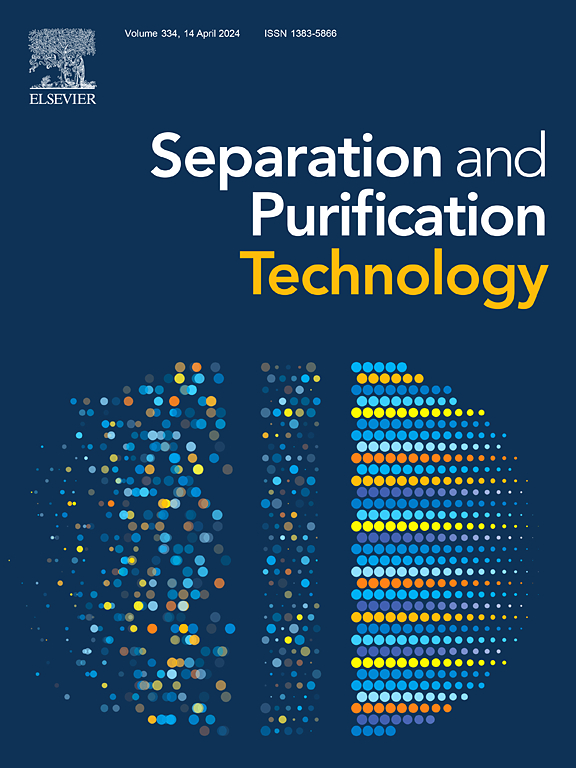具有增强抗(生物)污垢性能的吡唑功能化 PS-b-P4VP 嵌段共聚物聚硅氧烷膜
IF 9
1区 工程技术
Q1 ENGINEERING, CHEMICAL
引用次数: 0
摘要
嵌段共聚物(BCPs)的自组装在形成具有有序多孔结构的膜方面具有诸多优势,展示了其在膜分离应用中的潜在应用。然而,各种污物或生物污物在膜表面的自发积累严重阻碍了它们的实际应用。在不影响膜的多孔形态的前提下,对 BCPs 进行稳定的官能化处理以形成抗(生物)污垢表面是一种理想的选择。在此背景下,我们通过自组装聚苯乙烯-b-聚(4-乙烯基吡啶)(PS-b-P4VP)BCP,然后将吡啶分子与齐聚氮吡唑分子共价官能化,得到了双电荷(含有季铵化吡啶和齐聚氮吡唑分子)BCP-Py-Z 膜,从而制造出了一种等孔膜。官能化使膜具有抗(生物)污垢特性。功能化后,利用各种技术对季铵化吡啶和磺基甜菜碱吡唑鎓分子进行了彻底表征。得益于这种改性,BCP-Py-Z 膜对大肠杆菌和表皮葡萄球菌都具有很强的杀菌性能,并减少了有机化合物的堵塞。与受污垢严重影响的原始 BCP 膜相比,BCP-Py-Z 膜的 BSA 阻隔率(∼95%)和通量恢复率(∼92%)都要高得多。最重要的是,BCP-Py-Z 膜在连续的动态污垢实验周期中始终保持着水过滤和通量恢复的趋势。这项工作体现了一种简单而稳定的表面功能化方法,可赋予 BCP 膜强大的防污表面,这在各种膜过滤应用中证明是有利的。本文章由计算机程序翻译,如有差异,请以英文原文为准。


Zwitterionic pyrazole functionalized PS-b-P4VP block copolymer membranes with enhanced Anti(−bio)fouling properties
Self-assembly of block copolymers (BCPs) offers numerous advantages in forming membranes with ordered porous architectures, showcasing their potential applications in membrane-based separation applications. However, the spontaneous accumulation of various foulants or biofoulants on the membrane surface severely hampers their practical applicability. Establishing stable functionalization of BCPs to create an anti(−bio)fouling surface without compromising the porous morphology of membranes is an ideal choice. In this context, we fabricated an isoporous membrane through the self-assembly of polystyrene-b-poly(4-vinyl pyridine) (PS-b-P4VP) BCP followed by covalent functionalization of pyridine moieties with zwitterionic pyrazolium moieties to obtain dual-charged (containing quaternized pyridinium and zwitterionic pyrazolium moieties) BCP-Py-Z membrane. The functionalization imparted anti(bio)fouling properties to the membranes. After post-functionalization, the quaternized pyridine and sulfobetaine pyrazolium moieties were thoroughly characterized using various techniques. Benefitting from this modification, the BCP-Py-Z membrane exhibited robust bactericidal properties against both E. coli and S. epidermidis bacteria and resulted in reduced fouling with organic compounds. Compared to the pristine BCP membrane, which is severely affected by fouling, the BCP-Py-Z membrane exhibits a much higher BSA rejection (∼95 %) and flux recovery (∼92%). Most importantly, the BCP-Py-Z membrane consistently maintained its water filtration and flux recovery tendency throughout the continuous dynamic fouling experiment cycle. This work embodies a straightforward and stable surface functionalization method to endow BCP membrane with a strong antifouling surface, which proves advantageous for various membrane-based filtration applications.
求助全文
通过发布文献求助,成功后即可免费获取论文全文。
去求助
来源期刊

Separation and Purification Technology
工程技术-工程:化工
CiteScore
14.00
自引率
12.80%
发文量
2347
审稿时长
43 days
期刊介绍:
Separation and Purification Technology is a premier journal committed to sharing innovative methods for separation and purification in chemical and environmental engineering, encompassing both homogeneous solutions and heterogeneous mixtures. Our scope includes the separation and/or purification of liquids, vapors, and gases, as well as carbon capture and separation techniques. However, it's important to note that methods solely intended for analytical purposes are not within the scope of the journal. Additionally, disciplines such as soil science, polymer science, and metallurgy fall outside the purview of Separation and Purification Technology. Join us in advancing the field of separation and purification methods for sustainable solutions in chemical and environmental engineering.
 求助内容:
求助内容: 应助结果提醒方式:
应助结果提醒方式:


